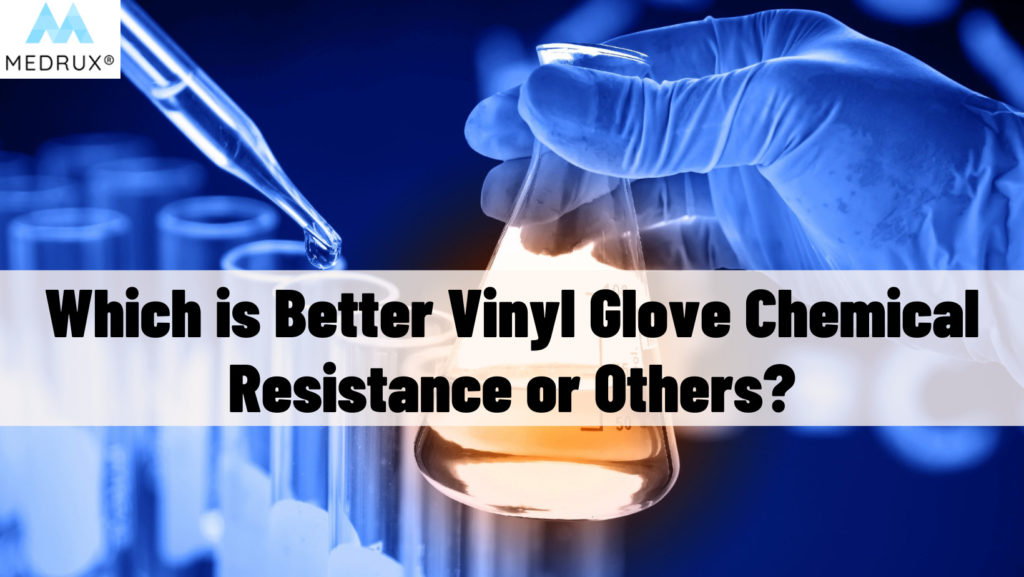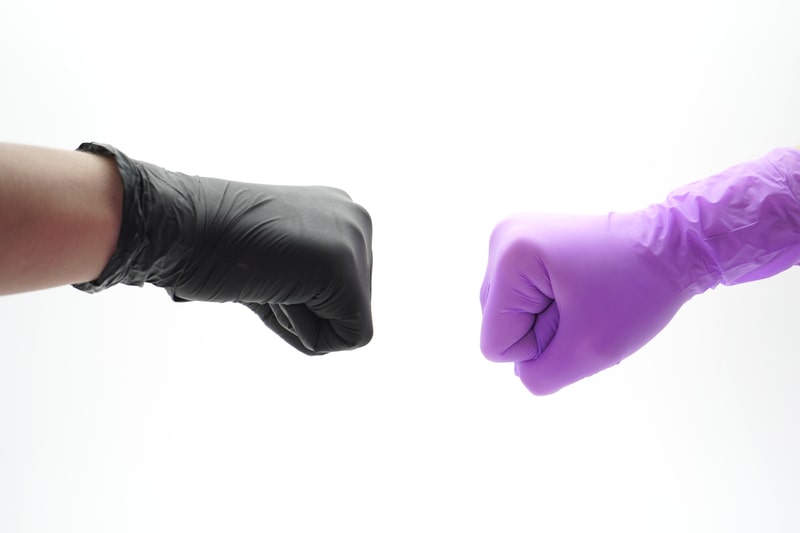Looking for a comparative article about the performance of vinyl gloves’ chemical resistance Vs. Other types of gloves?
Whether you are a chemist…
Or working with chemicals or harsh cleaning products?
And looking for the perfect hand protection against harsh chemicals?
If you are unsure how your gloves of choice will handle the chemicals or the harsh cleaning products you use, you have come to the right place.
Today we were going to talk about vinyl gloves’ chemical resistance and compare it to other types of gloves.
We will also dive into detail into different chemicals and which glove material is the best for protection against each.
But first of all, if we are going to talk about vinyl gloves’ chemical resistance, we need to know more about vinyl gloves in the beginning.
What are vinyl gloves?
Vinyl gloves are a synthetic, affordable, and disposable type of gloves.
Manufacturers make vinyl gloves from Polyvinyl chloride (PVC for short), which is a petroleum-based synthetic polymer that results from merging chlorine and ethylene monomers by polymerization.
However, PVC is a rigid material that needs further processing to become more flexible; that’s why companies add phthalate plasticizers in the manufacturing process. It makes PVC more pliable and soft to shape into gloves.
-
Uses of vinyl gloves
Generally speaking, vinyl gloves are popular because they are the cheapest option compared to latex and nitrile. But they also have a specific range of uses.
Mainly non-hazardous environments with low-risk tasks. Also, we need to mention that many people who suffer from latex allergy prefer vinyl gloves because they are absolutely latex free.
Moreover, vinyl gloves are anti-static, which is useful when working with cords and wires. They are also resistant to water, oils, and fats, Which comes in handy in many household tasks.
-
Applications of vinyl gloves
Short-duration tasks with frequent gloves changing. That’s because they are easy to put on and take off.
Non-hazardous tasks like cleaning, light plumbing, dishwashing, painting, cantering, and food processing.
Light medical examination with no contact with the patient’s bodily fluids.
-
Vinyl glove chemical resistance performance
Generally speaking, vinyl gloves do not offer excellent resistance to many chemicals; many scientists recommend using them in low-risk tasks and non-hazardous environments.
But to be more specific, we will be mentioning different chemicals. How good are vinyl gloves in protecting against them? We will also mention vinyl gloves alternatives briefly and what are the substances they safeguard against as well.
The low chemical resistance of vinyl gloves can be related to the fact that vinyl molecules have low molecular cohesion.
This means that the particles do not stick together when the gloves are stretched to a certain extent, plus vinyl gloves material is fragile, which makes them even weaker against harsh chemicals.
The same can also be said in terms of protection against microorganisms.
Another reason some people may choose not to use vinyl gloves is that they are not the most comfortable to wear, as they are less elastic than latex, for example.
And although it is a bit rare, some people may develop allergic reactions while using vinyl gloves.
However, it has nothing to do with latex allergy, and it is also much rare to find vinyl gloves allergy than it is to find latex glove allergy.
But, even though vinyl gloves’ strength and chemical resistance are a little questionable. You would be surprised to know that there are specific chemicals that vinyl gloves show excellent protection against.
Vinyl glove chemical resistance against:
- Ammonium hydroxide
- Battery acid
- Castor oil
- Citric acid
- Ethylene glycol
- Formaldehyde
- Formic acid
- Glycerine
- Hydrazine
- Hydrogen peroxide
- Hydroquinone
- Lactic acid
- Linseed oil
- Methylamine
- Monoethanolamine
- Perchloric acid
- Potassium hydroxide
- Picric acid
- Tannic acid
- Triethanolamine
You can safely wear vinyl gloves while using these chemicals. You wouldn’t need to worry about your gloves leaking and harming your skin.
The second list we will mention here is a list of chemicals to which vinyl gloves show fair resistance, meaning your exposure to these chemicals while wearing vinyl gloves should be limited.
As in limited exposure time and a limited amount of the chemical.
Vinyl gloves show fair chemical resistance to:
- Acetic acid
- Aniline
- Animal fat
- Butyl alcohol
- Carbolic acid
- Chromic acid
- Cottonseed oil
- Cyclohexanol
- Dibutyl phthalate
- Ethyl alcohol
- Hydraulic fluid
- Isobutyl alcohol
- Isopropyl alcohol
- Kerosene
- Linoleic acid
- Maleic acid
- Methyl alcohol
- Mineral oils and spirits
- Muriatic acid
- Nitric acid <70%
- Octyl alcohol
- Oleic acid
- Palmitic acid
- Pentachlorophenol
- Printer ink
- Propyl alcohol
- Phenol
- Sodium hydroxide <50%
- TCP
- Tung oil
- Turpentine
- Vegetable oil
If the chemical you are exposed to does not fall in these two lists, you should consider looking for vinyl glove alternatives. Now last but not least:
Chemicals we do not recommend using vinyl gloves while handling:
- Acetaldehyde
- Acetone
- Acetonitrile
- Amyl alcohol
- Benzaldehyde
- Benzene
- Benzoyl chloride
- Butyl acetate
- Carbon disulfide
- Carbon tetrachloride
- Cellosole
- Chlorobenzene
- Chloroform
- Chloronaphalenes
- Diethylamine
- DMF
- DMSO
- Dicotyl phthalate
- Dioxane
- Ethyl acetate
- Ethylene dichloride, trichloride
- Ethyl ether
- Freon
- Furfural
- Hexane
- Methyl acetate
- Methylene bromide
- Methylene chloride
- Methyl ethyl ketone
- Methyl isobutyl ketone
- Methyl methacrylate
- Morpholine
- Nitro benzene
- Nitro propane
- Pentane
- Propyl acetate
- Perchloro ethylene
- Propylene oxide
- Rubber solvent
- Stoddard solvent
- Styrene
- THE
- Toluene
- Tri chloro ethylene
- Xylene
What are the features of chemical-resistant gloves?
-
Lining
When manufacturing companies design and make gloves to be chemically resistant, another step is added to the process of glove manufacturing.
Other materials line the glove inside to add another protective layer against chemicals.
-
Thickness
Chemical-resistant gloves tend to be thicker to offer more resistance to harsh chemicals.
This feature adds more durability in case of repeated exposure to chemicals or exposure to a large dose of said chemicals.
What should you consider before choosing suitable chemical-resistant gloves?
- Type of chemical
- Amount of exposure
- Duration of exposure
- The concentration of the chemical
- The temperature of the chemical
Uses of chemical-resistant gloves:
When thinking about chemical-resistant gloves used, laboratories and chemistry students come to mind.
But chemicals are present in many fields like painting, working with adhesive materials, working on car engines, oil changes, and cleaning jobs.
And because safety comes first, chemically resistant gloves are one of the essential PPE equipment worldwide.
With that in mind, and by considering different types of chemicals and how they would react with different glove types, you should be able to decide what type of glove is the best for your unique use.
But what is a PPE:
PPE stands for “Personal Protective Equipment.” they are a collection of equipment and garments designed to keep you safe at work, home, or some potentially dangerous leisure activities.
PPE minimizes exposure to hazardous materials, workplace injuries, and illnesses that may result from contact with chemicals, radiation, or other workplace hazards like blood, body fluids, and many other threats you may face as a health care professional.
However, PPE doesn’t reduce the risk itself and doesn’t guarantee total protection.
In other words, wearing PPE is just one element and last resort in the safety equations and hierarchy of hazard control and implementing strategies to maintain a safe and healthy work environment.
What are the levels of PPE?
According to the EU regulation, PPE is any device or appliance an individual uses for protection against one or more health and safety risks.
PPE is separated into categories according to the risk it protects against.
Category I “Simple Design PPE”
The most basic, designed to protect you from minor hazards.
In other words, the minimal risks you can safely identify and deal with during your everyday life, such as:
- Contact with water and mild cleaning materials
- Contact with hot surfaces up to 50°C
- Sunlight exposure
- Non-extreme atmospheric conditions
Category I PPE examples are:
Cleaning gloves, gardening gloves, cut-resistant gloves, and regular sunglasses.
Category II “Neither simple nor complex.”
This category protects against physical, chemical, and electrical injuries.
In particular, injuries are not severe enough to cause death or permanent, irreversible damage. So they protect against intermediate risks between categories I and III.
They include most types of safety footwear, safety spectacles, goggles, industrial helmets, bump caps, and high-visibility clothing.
Category III “Complex design PPE.”
PPE in this category protects against risks that may cause serious events such as death or irreversible health damage.
- Hazardous substances and mixtures like some harsh chemicals
- Oxygen deficiency in the atmosphere
- Biohazard
- Ionizing radiation
- high-temperature environments of 100°C or above
- Low-temperature environments of – 50 °C or less
- Falling from a height
- Electric shocks
- Drowning
- Cuts by chainsaws
- High-pressure jets
- Bullet wounds
- Knife stabs
- Harmful noise.
Category III PPE includes fire-protective clothes, electrical insulation, protective helmets, safety goggles, respirators, and footwear.
In short, some types of PPE are for everyday use, while others are for specialized use in specific work environments.
And it is a corporate or workplace responsibility to ensure that the proper PPE level is established and that the workers receive adequate education and training on how to use and apply them.
It depends on the level of protection you need and the risk you’re exposed to in your work or daily life tasks.
And since we are explicitly discussing chemically resistant gloves.
As you may have noticed in our explanation of the 3 PPE levels, according to how harsh or dangerous the chemical you are using, chemically resistant gloves fall in either category II PPE or category III PPE.
Types of chemical-resistant gloves materials:
-
Latex
The oldest glove material, latex, is a natural rubber material known for being flexible, comfortable, environmentally friendly, and inexpensive.
The only downside to latex gloves is the allergenic reaction that some people develop against latex protein particles.
But if you are not allergic to latex, here is a list of chemicals that latex gloves can protect you against:
- Acetic acid
- Acetone
- Amyl alcohol
- Battery acid
- Butyl alcohol
- Castor oil
- Citric acid
- DMF
- DSMO
- Ethyl alcohol
- Ethylene glycol
- Formaldehyde
- Formic acid
- Furfural
- Glycerine
- Hydralazine
- Hydrochloric acid
- Hydrogen peroxide
- Hydroquinone
- Isobutyl, Isopropyl alcohol
- Lactic acid
- Methyl alcohol
- Methylamine
- Nitropropane
- Potassium hydroxide
- Sodium hydroxide
- Tannic acid
- Weed killer
-
Neoprene
Neoprene gloves are synthetic rubber gloves; they are heat, abrasion, and chemical resistant.
That’s why neoprene gloves are the gloves of choice for many industries that handle chemicals.
Neoprene gloves show excellent protection against:
- Alcohols
- Alkalis
- Aliphatic solvents
- Oils
- Organic acids
- Petroleum-based products
- Most cleaning products
But unfortunately, the downside to using neoprene gloves is that, they can lose their strong gr when wet.
-
Nitrile
Nitrile gloves material is a synthetic polymer called polyvinyl chloride or PVC. In manufacturing, they add plasticizers to make it more flexible and comfortable.
Nitrile gloves are famous for their flexibility, agility, and resistance to cuts, tears, and microorganisms. They are also recyclable, which is a massive advantage to the environment.
Nitrile gloves offer excellent protection against:
- Ammonium hydroxide
- Animal fat
- Asphalt
- Benzoyl alcohol
- Bleach
- Boric acid
- Brakes fluid
- Citric acid
- Creosote
- Cutting oil
- Cyclohexane
- Diesel fuel
- Diethanolamine
- Diethyl ether
- Ethyl alcohol
- Ethylene glycol
- Fertilizers
- Fluoride
- Formalin
- Fuel oil
- Gasoline
- Hexane
- Hydraulic fluid
- Hydrochloric acid
- Hydrogen peroxide
- Kerosene
- Linseed oil
- Methyl alcohol
- Mineral oil
- Oleic acid
- Phosphoric acid
- Pine oil
- Silicate
- Sodium hypochlorite
- Turpentine
- Vegetable oil
- Weed killer
- Wood preservatives
Many industries prefer nitrile gloves, like painting and varnish, food, automotive, and cleaning.
-
Butyl
Butyl gloves are a synthetic rubber type of gloves that has a dense molecular structure. These gloves resist many chemicals and oxidation, abrasion, and low temperatures.
Butyl gloves can protect you against the following:
- Aldehydes
- Amines
- Alcohols
- Concentrated acids
- Esters
- Peroxide
- Rockets fuel
- Strong bases
The only downside to using Butyl gloves is that they do not offer excellent protection against aliphatic and aromatic compounds.
-
Viton gloves
Viton or fluorocarbon gloves’ main component I fluoroelastomer.
This glove offers specific chemical resistance to chlorinated and aromatic solvents; they protect against Benzene, toluene, and polychlorinated biphenyl.
Also, they are very flexible. That’s why you can find Viton gloves in many laboratories.
Unfortunately, these gloves are the most expensive on this list.
-
Polyvinyl alcohol
Polyvinyl is a water-soluble synthetic material.
This glove material is highly resistant to games and has both aromatic and chlorinated solvents.
Polyvinyl gloves offer protection against:
- Aliphatic components
- Aromatic components
- Chlorinated solvents
- Esters
- Ketone
But, as we mentioned earlier, these gloves’ material is water soluble, that’s why they degrade quickly if you use them in water or water-based solvents.
-
Polyvinyl chloride
Polyvinyl chloride, or PVC for short, is a synthetic thermoplastic polymer material.
PVC gloves are arguably the best chemical-resistant gloves on the market.
PVC gloves offer excellent protection against:
- Acids
- Ammonium hydroxide
- Benzoyl alcohol
- Boric acid
- Chromic acid
- Creosote
- Diluted sulphuric acid
- Ethylene glycol
- Fats
- Fluoride
- Household detergents
- Methanol
- Petroleum hydrocarbons
- Photo developer fixer
- Phosphoric acid
- Silicate
That’s why you can find these gloves in maintenance, fishing, mining, construction, and mechanic work.
However, beware that PVC gloves do not offer protection against organic solvents. Also, they are not effective against high temperatures.
Want to choose the perfect Vinyl glove with chemical resistance?
-
Consider the breakthrough time
Breakthrough time is the time chemicals take to appear on the inner surface of the glove material. After this specific time, the glove is no longer resistant to the chemical.
-
Consider the permeability rate
It is the rate of the chemical movement through the glove, starting with absorption on the glove’s surface, then diffusion through the material, and then desorption on the internal surface of the glove.
Unlike breakthrough time, the permeability rate is not a numerical value. It falls into four categories: Excellent, Good, Fair, and Poor.
-
Consider the degradation
This happens when the glove is not resistant to a specific chemical or exposed to a chemical beyond the intended timing or concentration.
This is the change like the glove due to the exposure to chemicals; it can happen in the form of swelling, softening, shrinkage, or cracking of the glove material.
Adding to that, you should keep a critical detail in mind.
When you mix two or more different chemicals, the physical and chemical properties of your product changes completely, so even if your gloves are chemically resistant to your original components, they may be useless to use against the resulting new product.
That’s why you should always know what chemicals you must deal with throughout the process.
Now that we got this all covered, let’s answer some frequently asked questions:
When should I change my vinyl gloves?
Generally speaking, if your gloves are still intact, you can still use them.
However, you should be aware that no matter how chemically resistant your gloves are, they will degrade with prolonged exposure.
Of course, if you detect any holes or punctures, you should change them immediately.
Other than that, you can use your gloves for the duration of their specific breakthrough time, as we mentioned earlier.
How to remove contaminated vinyl chemical-resistant gloves?
Taking off chemically contaminated gloves is very important because you have to ensure that your bare skin does not touch the surface of the gloves at any step of the process.
- Pinch the cuff of your dominant hand’s glove from the outside and avoid touching your bare skin.
- Peel your dominant hand’s glove outwards, turning it inside out.
- Keep your removed glove in your glove, and slide two fingers from your dominant hand inside the other glove. While doing so, again, do not touch the outside of the glove with your bare fingers.
- Peel off the second glove from the inside as well while holding the first glove inside your gloved hand.
- After you Peel the second glove off, you will end up with ball-shaped gloves.
- Dispose of your glove ball in the proper disposal pin.
How to dispose of used vinyl chemical-resistant gloves?
It is essential to provide employee training to all employees that may have to deal with hazardous materials regarding how to dispose of chemically contaminated gloves to avoid causing cross-contamination and any environmental damage.
Gloves contaminated by chemicals are hazardous waste. This means that these gloves should not be recycled. They should go to landfills.
Depending on the type of chemical you use your gloves while handling, the waste bag color that you use differs.
For example, if you used your gloves to handle chemotherapeutic medication, you used gloves that are cytotoxic or cytotoxic waste. You must put them into yellow and purple bags to be sent to authorized facilities.
What are landfills?
Landfills are well-managed facilities used for the disposal of solid waste.
They are also well-monitored to ensure compliance with federal regulations.
Moreover, they are designed to protect the environment from other contaminated waste. Landfills must have environmental monitoring systems.
The primary role of these systems is to check for any sign of groundwater contamination or landfill gas.
Also, many different types of landfills depend on their hazardous waste type.
Moreover, landfills can not be in environmentally sensitive areas. There are specific standards for building landfills and their location.
To sum it up,
Your hands are precious, and you should always beware of what may affect them in your work or daily life. Chemicals are everywhere, even if you don’t work on them directly.
They are in your cleaning products and your car, for example. And to know which type of glove to use, you need to know first what chemicals you are using.
Vinyl glove chemical resistance may not be the best, but they offer protection against many chemicals.
We hope we can clarify which glove to use while handling most different chemicals you may have to come across.
Stay safe, and ask us any questions you want in the comments.
We will be more than happy to help.
Hajar Nagdy is a microbiologist and a lecturer. Nagdy holds a Bachelor’s degree in the fields of microbiology and environmental sciences, and she is now a M.Sc. candidate in microbiology. In her free time, she can be found listening to classical music, reading interesting scientific articles, running a charity, or traveling across Europe.








